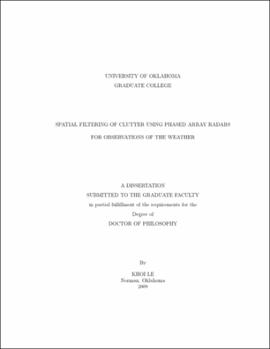| dc.description.abstract | Phased array radars are attractive for weather surveillance primarily because of their capacity for extremely rapid scanning through electronic steering. When combined with the recently developed beam multiplexing technique, these radars can provide significantly improved update rates, which are necessary for monitoring rapidly evolving severe weather. A consequence of beam multiplexing, however, is that a small number of contiguous time series samples are typically used, creating a significant challenge for temporal/spectral filters typically used for clutter mitigation. As a result, the accurate extraction of weather products can become the limiting performance barrier for phased array radars that employ beam multiplexing in clutter-contaminated scattered fields. By exploiting the spatial correlation among the signals from the elements of the phased array antenna, the effect of clutter contamination can be reduced through a processed called spatial filtering . In contrast to conventional temporal filtering, spatial filtering is used to adaptively adjust the antenna beam pattern to produce lower gain in the directions of the undesired clutter signals. In this dissertation, the effect of clutter mitigation using spatial filtering was studied using numerical simulations of a tornadic environment and an array antenna configuration similar to the NSSL NWRT Phased Array Radar for changes in signal-to-noise ratio, clutter-to-signal ratio, number of time series samples, and diagonal loading for three types of clutter sources that include nearly stationary ground clutter, moving targets such as aircraft, and wind turbine clutter, which has recently been documented to be increasingly problematic for radars. Since such data are not currently available from a horizontally pointed phased array weather radar, experimental validation was applied to an existing data set from the Turbulent Eddy Profiler (TEP) developed at University of Massachusetts, which is a vertically pointed phased array radar. Results will show that spatial filtering holds promise for the future of phased array radars for the observation of the weather in a clutter environment. | |
